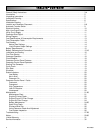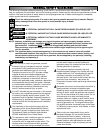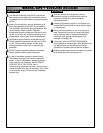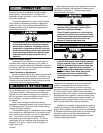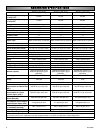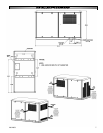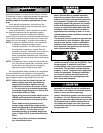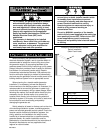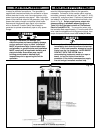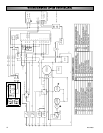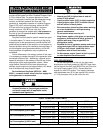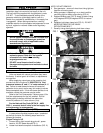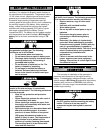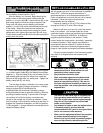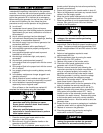
200-265310
Once the generator is anchored in its final position, it
is ready for electrical connections. The generator is
supplied with two terminal blocks for connection of three
distinct electrical circuits; main line output power, utility
power input and generator start signal. Main line output
power is the electrical output of the generator, utility input
powers the battery charger and optional block heater
devices and the generator start signal is the interface
with an Automatic Transfer Switch that allows the
generator to operate automatically upon a utility power
outage.
The output circuit of the generator is 4-wire, 240V,
rated for the amperage as shown on the generator
nameplate. Connection to the transfer switch requires
two leads, commonly referred to as "hot" leads (L1 & L2),
a neutral (N), and ground lead. Positions of these leads
are labeled on the main line output terminal block, also
shown in Fig. A. Select proper power output wire
sizes according to allowable ampacities given in
Table 310-16 of the latest revision of The National
Electric Code(NFPA 70). To connect the wires, strip
the insulation back approximately ½" from the end of the
wire, insert the stripped end into the terminal block, then
torque the terminal block screw to 35 in-lbs (4.0 N-m).
EE
EE
LL
LL
EE
EE
CC
CC
TT
TT
RR
RR
II
II
CC
CC
AA
AA
LL
LL
HH
HH
OO
OO
OO
OO
KK
KK
UU
UU
PP
PP
WWAARRNNIINNGG
• In case of accidents caused by electric shock,
immediately shut down the source of electrical
power. If this is not possible, attempt to free the
victim from the live conductor. AVOID DIRECT
CONTACT WITH THE VICTIM. Use a
nonconducting implement, such as a rope or
board, to free the victim from the live
conductor. If the victim is unconscious, apply
first aid and get immediate medical help.
DDAANNGGEERR
• Improper installation can damage your
electrical system and cause property damage,
serious personal injury or death. Installation
MUST be performed by a licensed electrician
and plumber, or gas technician and installation
MUST comply with all applicable building and
electrical codes. Some areas may require
building permits and/or detailed sight
inspections prior to approving the unit for
operation.
MM
MM
AA
AA
II
II
NN
NN
LL
LL
II
II
NN
NN
EE
EE
OO
OO
UU
UU
TT
TT
PP
PP
UU
UU
TT
TT
PP
PP
OO
OO
WW
WW
EE
EE
RR
RR
Fig. A



